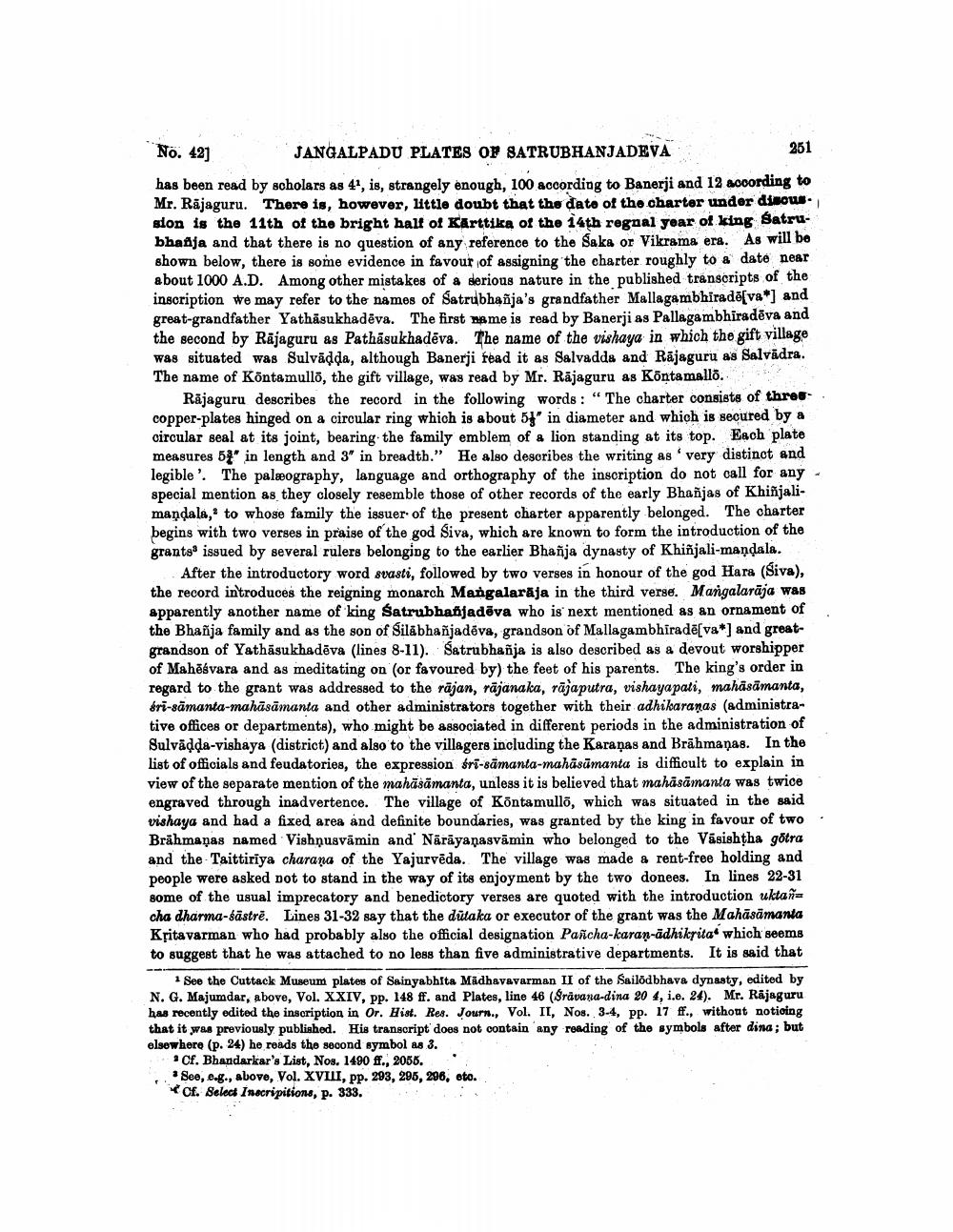________________
361
No. 42] 'JANGALPADU PLATES OP SATRUBHANJADEVA has been read by scholars as 4", is, strangely enough, 100 according to Banerji and 12 according to Mr. Rājaguru. There is, however, little doubt that the data of the charter under dimous. sion is the 11th of the bright halt of Kärttika of the 14th regnal year of king Satru bhatja and that there is no question of any reference to the Saka or Vikrama era. As will be shown below, there is some evidence in favour of assigning the charter roughly to a date near about 1000 A.D. Among other mistakes of a serious nature in the published transcripts of the inscription we may refer to the names of Satrubhañja's grandfather Mallagambhiradē va *] and great-grandfather Yathāsukhadēva. The first name is read by Banerji as Pallagambhiradēva and the second by Rajaguru as Pathāgukhadēva. The name of the vishaya in which the gift village was situated was Sulvādda, although Banerji read it as Salvadda and Rājaguru as Salvadra. The name of Köntamullo, the gift village, was read by Mr. Rajaguru as Köntamallo.
Rajaguru describes the record in the following words: "The charter consists of three copper-plates hinged on a circular ring which is about 51' in diameter and which is secured by a circular seal at its joint, bearing the family emblem of a lion standing at its top. Each plate measures 54" in length and 3" in breadth.” He also describes the writing as 'very distinct and legible'. The palæography, language and orthography of the inscription do not call for any special mention as they closely resemble those of other records of the early Bhañjas of Khiñjalimandala,' to whose family the issuer of the present charter apparently belonged. The charter begins with two verses in praise of the god Siva, which are known to form the introduction of the grants issued by several rulers belonging to the earlier Bhañja dynasty of Khiñjali-mandala.
After the introductory word svasti, followed by two verses in honour of the god Hara (Siva), the record introduces the reigning monarch Mangalaraja in the third verse. Mangalarāja was apparently another name of king Satrubhañadēva who is next mentioned as an ornament of the Bhañja family and as the son of Silabhañjadeva, grandson of Mallagambhiradē[va*] and greatgrandson of Yathāsukhadēva (lines 8-11). Satrubhañja is also described as a devout worshipper of Mahēgvara and as meditating on (or favoured by) the feet of his parents. The king's order in regard to the grant was addressed to the rājan, rājanaka, rājaputra, vishayapati, mahāsāmanta, fri-sāmanta-mahāsāmanta and other administrators together with their adhikaranas (administrative offices or departments), who might be associated in different periods in the administration of Sulvādda-vishaya (district) and also to the villagers including the Karanas and Brāhmaṇas. In the list of officials and feudatories, the expression sri-sāmanta-mahasūmanta is difficult to explain in view of the separate mention of the mahäsämanta, unless it is believed that mahāsāmanta was twice engraved through inadvertence. The village of Kõntamullo, which was situated in the said vishaya and had a fixed area and definite boundaries, was granted by the king in favour of two Brāhmaṇas named Vishnusvämin and' Nārāyaṇasvāmin who belonged to the Vāsishtha gotra and the Taittiriya charana of the Yajurvēda. The village was made & rent-free holding and people were asked not to stand in the way of its enjoyment by the two donees. In lines 22-31 some of the usual imprecatory and benedictory verses are quoted with the introduction uktaña cha dharma-bästrē. Lines 31-32 say that the dutaka or executor of the grant was the Mahāsāmanta Kritavarman who had probably also the official designation Pancha-karan-adhikrita which seems to suggest that he was attached to no less than five administrative departments. It is said that
See the Cuttack Museum plates of Sainyabhita Madhavavarman II of the Sailodbhava dynasty, edited by N. G. Majumdar, above, Vol. XXIV, pp. 148 ff. and Plates, line 46 (Sravana-dina 20 4, i.e. 24). Mr. Rajaguru has recently edited the inscription in Or. Hist. Res. Journ., Vol. II, Nos. 3-4, pp. 17 ff., without noticing that it was previously published. His transcript does not contain any reading of the symbols after dina; but elsowhore (p. 24) he roads the second symbol as 3.
Cf. Bhandarkar's List, Nos. 1490 ff., 2008. .. See, e.g., above, Vol. XVIII, pp. 293, 295, 296, eto.
Cf. Select Inscriptions, p. 333.




